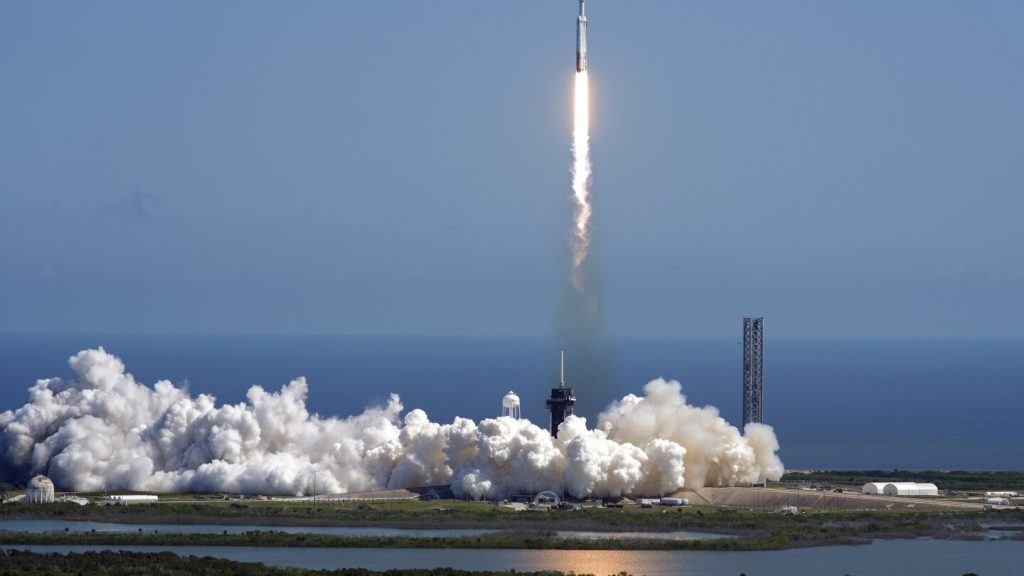On Monday, NASA launched the Europa Clipper spacecraft on an ambitious mission to explore the moon Europa, which orbits Jupiter. This mission aims to determine whether Europa’s hidden ocean could harbor the conditions for life, making it one of the most intriguing bodies in our solar system. The spacecraft will spend approximately 5.5 years traveling on a journey of over 1.8 billion miles, before entering orbit around Jupiter and conducting multiple flybys of Europa. Scientists are increasingly convinced that a global ocean lies beneath Europa’s thick icy surface, and by examining this moon, they hope to gather clues about the potential for life beyond Earth.
The Europa Clipper is not equipped to actively search for life forms, but it will investigate the essential ingredients required to sustain life. This includes scouring the surface for organic compounds and suitable environmental conditions beneath the ice. The spacecraft was launched using a Falcon Heavy rocket from Florida’s Kennedy Space Center, successfully separating from the upper stage afterward and communicating back to mission control, as celebrated by NASA’s Jet Propulsion Laboratory representatives and officials at the launch site.
Despite facing delays, including concerns about the spacecraft’s transistors being potentially vulnerable to Jupiter’s radiation, mission leaders affirmed that they could proceed as planned. Each of Europa Clipper’s 49 flybys will expose the spacecraft to radiation levels equivalent to millions of chest X-rays. After a thorough review of the components, NASA confirmed the mission could continue, demonstrating resilience in overcoming potential setbacks. The launch was originally delayed due to Hurricane Milton, adding further challenges to the endeavor.
The Europa Clipper spacecraft is designed with precautions in mind. It boasts a size similar to a basketball court when its solar wings are deployed, and it will utilize gravity assists from Mars and Earth to gain speed on its journey to Jupiter. The spacecraft, weighing almost 13,000 pounds, is expected to reach its destination by 2030, where it will complete a series of orbit cycles around the gas giant every 21 days, with periodic close encounters with Europa itself. During these close flybys, it will skim the surface at altitudes as low as 16 miles, making it closer than previous missions.
With a suite of nine specialized instruments on board, the Europa Clipper will attempt to penetrate and analyze the moon’s ice layer, estimated to be up to 15 miles thick, and gather data from the ocean believed to be over 80 miles deep. These instruments are safeguarded within a radiation-protective vault composed of dense zinc and aluminum, ensuring the ongoing functionality of the electronics for the duration of the mission, which is set to last until 2034.
The mission to explore Europa raises profound questions about extraterrestrial life. If conditions conducive to life are confirmed on Europa, it could suggest similar possibilities on other ocean worlds within our solar system and beyond. Scientists are particularly interested in locations such as Saturn’s moon Enceladus, which also exhibits subsurface oceanic features and geysers. The Europa Clipper mission represents a critical step in our understanding of life’s potential in these distant realms, forging a pathway for future discoveries in astrobiology and planetary science.
Overall, the Europa Clipper mission not only symbolizes NASA’s ongoing exploration of the outer solar system but also underscores the human drive to seek answers regarding life beyond our home planet. With its advanced technology and rigorous scientific approach, the mission heralds a new chapter in astrobiology, potentially reshaping our comprehension of life in the universe. The collaborative effort between agencies and scientists showcases humanity’s pursuit of knowledge, fostering excitement and curiosity about what lies beneath the icy shell of Europa and in the broader cosmos.

